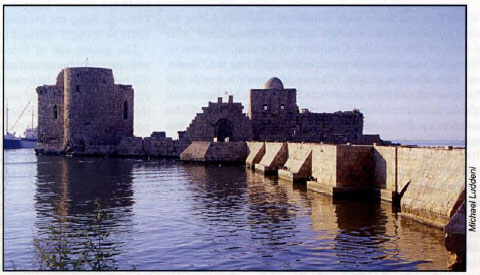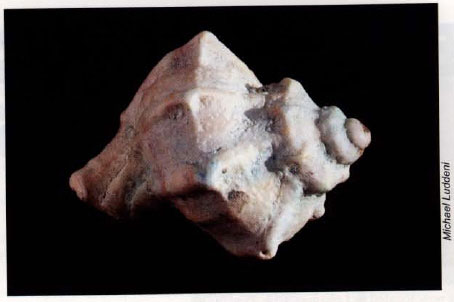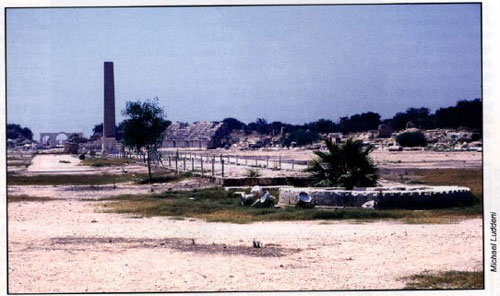
This article was first published in the Fall 2002 issue of Bible and Spade.
The names Tyre and Sidon were famous in the ancient Near East. They are also important cities in the Old and New Testaments. Both are now located in Lebanon, with Tyre 20 mi south of Sidon and only 12 mi north of the Israel-Lebanon border. Today each is just a shadow of their former selves.
Sidon, called Saida today (Arabic for “fishing”), was named after the firstborn son of Canaan (Gn 10:15) and probably settled by his descendants. The northern border of ancient Canaan extended to Sidon (Gn 10:19). Later, Jacob spoke of it as the boundary of Zebulun (Gn 49:13) and Joshua included it as part of the land promised to Israel (Jos 13:6). Sidon was included in the inheritance of Asher, on its northern boundary (Jos 19:28), but it was not taken by that tribe in conquest (Jgs 1:31, 3:3). Settled from the beginning as a port city, Sidon was built on a promontory with a nearby offshore island that sheltered the harbor from storms.
Twenty mi south of Sidon, in the middle of a coastal plain, Tyre (called Sour in Arabic today) was constructed on a rock island a few hundred yards out into the Mediterranean (Ward 1997:247). In fact, the city took its name from this rock island. Tyre comes from the Semetic sr (Hebrew Sor, Arabic Sur, Babylonian Surru, Egyptian Dr,) meaning rock.

The port of ancient Sidon is believed to have been located in this area. The Sea Castle in the harbor today was originally built as a Crusader fort to protect the harbor. It is believed the Castle sits over the site of the Phoenician temple to Melkart. Michael Luddeni
Located at the foot of some of the Lebanese mountain’s southwestern ridges and near the gorge of the ancient Leontes River (the modern Litani), the rich and well-watered plain became the fortified island’s primary source or food, water, wood and other living essentials. Apparently the island was fortified first and called Tyre, while the coastal city directly opposite was settled later. It was originally called Ushu in cuneiform texts (Ward 1997:247) and later Palaetyrus (“old Tyre”) in Greek texts (Jidejian 1996:19).
The Canaanites
Historical and archaeological evidence indicate both cities were settled by the early second millennium BC and were important seaports long before the Israelites settled in Canaan. Yet, while Sidon was mentioned many times during the Canaanite and early Israelite periods in the Bible, Tyre first appeared as part of Asher’s western boundary (Jos 19:29). Specifically called a “fortified city” in this passage, it was noted as a significant landmark. Tyre does not appear again in the Bible until Hiram, king of Tyre, sends cedar, carpenters, and masons to build David’s house (2 Sm 5:11).
While both cities are mentioned in a number of second millennium BC extra-Biblical documents, the most interesting accounts come from the Amarna Letters. Actual letters from the kings of both cities were found among the Amarna Letters (ca. 1350 BC). Zimrida, king of Sidon wrote one (EA [El Amarna] 144, ) or maybe two (EA 145) of the Amarna Letters. Abi-Milki, king of Tyre, sent ten letters to the Egyptian Pharaoh (EA 146–155).

This murex shell was fished out of the Mediterranean Sea by a local fisherman and given to ABR director Dr. Bryant Wood when he visited Tyre. Still found in the Mediterranean today, the ancients collected thousands of these mollusks to produce just one ounce of purple dye. It was such a costly process that purple clothing was considered a symbol of wealth and royalty. Michael Luddeni
Although the dates of Homer’s Iliad and Odyssey are still in dispute, only Sidon and Sidonians are mentioned (17 times: Iliad 6.290–91; 23.743-44; Odyssey 4.83, 84, 618; 13.272, 285; 14.288, 291; 15.118, 415, 417, 419, 425, 473). Yet the failure to mention either Tyre or Tyrians may not be significant. At least some of Homer’s usage appears to relate the term Sidonian with Phoenicians in general (see also 1 Kgs 5:6; Jidejian 1996:60). It would seem that during the second millennium BC, Sidon was the pre-eminent of the two port cities. It also appears, during the first millennium BC, that Tyre eclipsed Sidon.
The Phoenicians
While Tyre and Sidon were considered Canaanite during the second millennium BC, scholars call the Lebanese coast after the time of the Israelite Conquest of Canaan, Phoenecia. “Phoenicia” was the name given to the region by the Greeks, from their word for purple. The ancient world’s purple dye industry developed from extracting a fluid from a Mediterranean mollusk, the murex. Not only did the people of the Phoenician coast develop this industry, they specialized in shipping this very valuable commodity all over the Mediterranean world.
Beginning with David, the Tyrian connection became prominent. Hiram, king of Tyre, offered cedar trees, carpenters and masons to build David’s palace (2 Sm 5:11). To what extent cedars were used in David’s house is unclear, but David did consider his abode to be a palace of cedar (2 Sm 7:2), and God seemed to agree (2 Sm 7:7). Later David utilized the help of Sidonians and Tyrians to provide cedar trees for the Temple (1 Chr 22:4).
Hiram also offered to bring cedars down from the mountains and float them down the Mediterranean coast to Joppa for Solomon’s royal construction projects (1 Kgs 5:8–11; 2 Chr 2:16), which included both his palace and the Temple. Interestingly, while Hiram continued to be the dominant Lebanese contact, Solomon spoke of the woodworking skills of the Sidonians (possibly just a generic term for Phoenicians?) and builders from Gebal, known by the Greeks as Byblos (1 Kgs 5:18).
Ethbaal was the father of Jezebel and king of Sidon (1 Kgs 16:31). Many scholars follow Josephus (Against Apion 1.121-24; Antiquities 8), who was quoting Menander, and identify Ethbaal with Ithbaal (Hebrew “Man of Baal”), priest of Astarte who killed the king of Tyre and seized the throne (Jidejian 1996:73, 306). In fact, during many periods, the king of one city seemed to be considered king of the other city by outsiders.
Nebuchadnezzar, king of Babylon, besieged Tyre for 13 years (585–572 BC), but the precise historical facts of its outcome are still unclear. He evidently did not conquer the city, but it may have surrendered conditionally to him. Both Jeremiah (27:3–11) and Ezekiel (26:7–14) spoke of this event. Apparently both Tyre and Sidon surrendered to Nebuchadnezzar, based on a fragmentary Babylonian administrative document which mentions the kings of Tyre and Sidon as receiving rations from the royal Babylonian household (Pritchard 1969a: 308).
In the days of Ezra and Zerubbabel, the Jews returning from captivity also sent to the men of Sidon and Tyre for cedars to build the Second Temple. Again cedars were floated from Lebanon along the Mediterranean coast to Joppa, where they could be brought overland to Jerusalem (Ezr 3:7).
The golden age of Sidon was still to come. Beyond its prominence in the second millennium BC, Sidon’s greatest days did not come until after the days of Nebuchadnezzar. The port city reached its peak of power through its worldwide trade in the murex dye and glass industries. At the same time, it continued to be among the eastern Mediterranean’s leaders in shipbuilding and shipping.
Alexander the Great
While Tyre seemed to withstand Nebuchadnezzar, it was not prepared for Alexander 250 years later. Although every Phoenician city to the north, including Sidon, welcomed Alexander, Tyre would only agree to surrender nominally to him. They would not allow him entrance to the city, which was exactly what Alexander intended to do. Not be denied, after only a seven-month siege of the island city, he did what no one else had ever considered possible. Utilizing stones, timber, dirt and debris from the mainland, Alexander constructed a causeway out into the Mediterranean. At last he reached the island, breached the city wall and slew or put into slavery the defiant Tyrians. An amazing feat, Tyre was changed forever.

The city of Tyre was originally an island which Alexander the Great later joined to the mainland by a causeway. In time the causeway was enlarged by rubble and sand deposits washed up by waves. This 1873 map shows Tyre as it was in 322 BC, and later as a peninsula stretching out into the Mediterranean Sea. Evidence of Tyre’s ancient harbors can still be seen on the peninsula’s north and south sides.
Ezekiel referred to this event long before it happened. While also mentioning that God would send Nebuchadnezzar against the city (Ez 26:7), he spoke of the LORD’s promise to destroy Tyre, scrape her dust from her, make her smooth like the top of a rock and a good place for spreading out nets to dry (Ez 26:4, 14). Ezekiel also pointed out that Tyre’s world-wide trade would cease with this event (Ez 27 and 28). Illustrating Ezekiel’s description of Tyre’s destruction, Jidejian (1996:13–14) noted that over the past three centuries, Tyre has served as a “quarry” for the whole coast. Her stones may be found as far away as Beirut (40 mi north) and Akko (25 mi south in Israel).
Ezekiel also prophesied of God’s judgment against Sidon (Ez 28:20–24). God promised pestilence, blood in her streets and death by sword (Ez 28:23). Sidon incurred the wrath of the Persian King Artaxerxes who beat the city into submission. This may have been the event Ezekiel described.
The New Testament Period
By virtue of its submission to Alexander, Sidon under the Greeks enjoyed relative freedom and an advanced cultural life. In the early days of the Roman Empire, Sidon even had enough autonomy to have its own senate and mint its own coins. Unfortunately for archaeologists, the area of ancient Sidon remains occupied today and only minimal archaeological evidence for New Testament Sidon is available.
Meanwhile, Tyre also recovered from Alexander’s devastation. In 126 BC, now a peninsula extending into the Mediterranean, Tyre became a Roman province and later the capital of Rome’s Syria-Phoenician province.
The site of the ancient mainland city became a large and ornate Roman necropolis. Here also was built a typical Roman hippodrome, the best preserved in the world today. An east-west colonnaded street, a huge triple-bay triumphal arch and a water aqueduct also extended from this area toward the sea.
On the island of Tyre, near the site of the ancient Egyptian (southern) port today sits impressive ruins from the Roman and Byzantine periods. These include a western extension of the colonnaded street from the mainland site, the agora (market place), an unusual arena, and a huge bathhouse.
Thus, New Testament Tyre and Sidon were prosperous Roman port cities. Yet there was great spiritual hunger in the region. Early in Jesus’ ministry, people from Sidon and Tyre heard about the things He did. They came to see Him (Mk 3:8) and be healed by Him (Lu 6:17).
Later in His ministry, Jesus visited the region of Sidon and Tyre. There He healed the Canaanite (Syrophoenician) woman’s daughter (Mt 15:21–28; Mk 7:24–31). This was the same area where God sent Elijah when the widow fed him (1 Kgs 17:9). Elijah’s visit was to the port city of Zaraphath (Serepta to the Greeks and modern Sarafand), almost mid-way between Sidon and Tyre. Both these Old and New Testament visits to the region may be a reminder that the Promised Land extended as far north as Sidon. While full of non- Israelites, it was still part of Israel’s inheritance.
Jesus pronounced judgment on Chorazin and Bethsaida suggesting that if the pagan cities of Tyre and Sidon had experienced what Chorazin and Bethsaida did, they would have long ago repented in sackcloth and ashes (Mt 11:21–24).
The inhabitants of Sidon and Tyre offended Herod Agrippa I and came to visit him at Jerusalem. While both were significant Roman cities on the eastern Mediterranean, their leaders felt the need to keep in Herod’s favor. This visit was the occasion of Herod’s death at God’s hand (Acts 12:20–23).
When Paul returned to Palestine from his third missionary journey, he sailed into Tyre. He met with a group of disciples there and spent seven days in the city (Acts 21:3–7). He probably walked the colonnaded street, passing the hippodrome.
After his arrest in Jerusalem and imprisonment in Caesarea, Paul was taken as a prisoner to Rome. From Caesarea his ship stopped at Sidon and Paul was allowed to meet with a group of disciples in that city (Acts 27:3).
Sidon and Tyre Today
Sidon was the scene of heavy fighting during Lebanon’s civil war and it’s situation only deteriorated during the subsequent 22-year Israeli occupation. Even today, there is only one hotel and few restaurants for tourists. With numerous hammams (Turkish baths), souqs (markets) and mosques, it feels like an old world city. There is little industry and the port services only a minimal number of local fishing vessels.
Unfortunately, because the ancient port area has continued to be inhabited over the millennia, there is little archaeological evidence or Bronze and Iron Age Sidon. Ruins of the Castle of St. Louis on a hill south of the port are believed to sit over the ancient acropolis. Just south of the castle is Murex Hill, once ancient Sidon’s garbage dump. The mound was formed by tens of thousands of crushed murex shells from the city’s famed purple dye industry.
Today Tyre is a depressed city that suffered greatly during Lebanon’s civil war and Israel’s subsequent occupation of southern Lebanon. The modern isthmus that joins the island to the mainland holds streets of houses and shops. There is a picturesque fishing harbor on the north side of the isthmus, adjoining a lively souq. The administrative center for a number of nearby villages and towns, Tyre has a number of unplanned squatter settlements. As important as any industry to modern Tyre are the Greek and Roman archaeological remains which cover the ancient mainland city of Palaetyrus, the accumulated isthmus and the island city.

The hippodrome at Tyre is the best preserved in the world. Once seating 20,000 spectators, the course is 480m (525 yds) long. Primarily constructed for chariot races, as in the movie Ben Hur, the ends of this racing oval were marked by turning stones called metae which still sit in place. The tight high-speed turns at the metae created the most exciting and dangerous part of the race, often leading to dramatic collisions and spills. Modern Tyrians use the hippodrome today as a jogging course. Michael Luddeni
Our visit to Lebanon gave me a new appreciation of many Biblical passages. I never really considered the rich historical connections Tyre and Sidon had with Scripture. Outside of modern Israel, it is easy to forget that God specifically mentioned these cities as part of the Promised Land. Even in the New Testament, Jesus and Paul took the time to minister to the people of these cities. Not Israelite by population and pagan by religious practice, God continued to bring to them a witness of His love and power.
Bibliography
Jidejian, N.
1996 Tyre Through the Ages. Beirut: Librairie Orientale.
Josephus
1992 The Works of Josephus. Trans. W. Whiston, from Latin. Peabody MA: Hendrickson.
Pritchard, J. B., ed.
1969a Ancient Near Eastern Texts Relating to the Old Testament, third edition. Princeton: Princeton University Press.
1969b The Ancient Near East in Pictures, second edition. Princeton: Princeton University Press
Ward, W. A. 1997 Tyre. Pp. 247–50 in the Oxford Encyclopedia of Archaeology in the Ancient Near East 5, ed. E. M. Myers. New York: Oxford University Press.